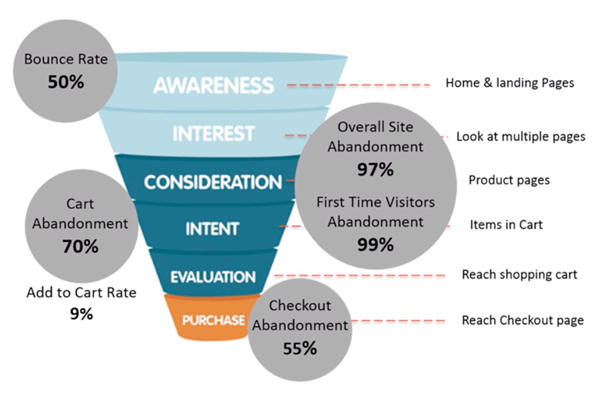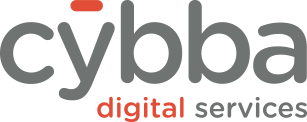You’ve heard of cart abandonment. But what exactly is browse abandonment? And what can you do to avoid it?
Browse abandonment is when a customer visits a website, views the products or services displayed throughout the site, but leaves without adding anything to their cart or completing a transaction.
Browse abandonment can be thought of as window shopping - looking at the products or services, but not taking any action that demonstrates interest. From the funnel perspective, it is any abandonment that happens up to the Consideration stage, and right before Intent.

This type of abandonment is separate from cart abandonment and occurs at extremely high rates. 97% of website visitors, to be exact, will abandon a site without taking any action.
While cart abandonment gives an idea of the customer’s interests, browse abandonment leaves the brand without any idea of why that customer was on their site in the first place. Both instances contribute to revenue loss.
There are multiple potential causes of browse abandonment, and while it is nearly impossible to eradicate, there are solutions that not only help mitigate the high rates, but can drive more traffic and conversions as well.
Browse Abandonment Solutions
There will be instances where onsite improvements can prevent a user from leaving the site. We’ll explore some of the improvements you can make and some post-abandonment solutions to help you recover lost visitors.
First, let’s identify the objectives needed to minimize abandonment rates. Then, we’ll dive into the actual tactics themselves.
Objective: Understand the friction points on your website
Solution: Listen to your customer base
Sit in on sales and customer success calls. Take a proactive approach and find areas of confusion and frustration with customer feedback and website analytics. For example, if users are unclear on your solutions’ pricing structure, then create collateral to address pricing. Shipping, billing information, and return policies are also very important to customers. If a brand does not clearly communicate its general policies, a customer will be less inclined to purchase from them.
Objective: Enhance website aesthetic and usability
Solution: Nail your website's first impression
First impressions are everything. And what are the main factors contributing to a website’s first impression? If you said “The look and feel of it” – you’re right! You should never underestimate the power of eye-popping visuals.
A user only takes 50 milliseconds to form an opinion about a website, so create that first positive impression and grab their attention as soon as they land on site. The key is to keep the layout simple, yet creatively unique to set yourself apart from the competition. A user should instantly recognize your brand from the website’s layout and artistic theme alone, not just from the logo on your homepage.
A predictive and intuitive layout will allow for seamless navigation - the less thinking required to navigate your site, the fewer abandonments you’ll see. Avoid blocks of text and maintain a moderate balance of imagery and animative features. When it comes to proactive engagements, you don’t want to be overly aggressive. Users are already exposed to so many ads– around 4,000 to 10,000 each day, and people become distracted and overwhelmed easily. Don’t divert attention from the main CTAs on the web page, which should always be visible and just a short drag of the mouse away.
Objective: Generate product interest
Solution: Optimize product descriptions
The opposite of abandonment – take the user to the next step with the perfect positioning and presentation of your products. Product descriptions should be both descriptive and concise. Focus on the unique features of what you’re offering, while avoiding any unnecessary language. Build a 360-degree view of the products with as much detail and interaction as possible, so users can imagine themselves physically handling the product themselves.
Once you’re happy with the products’ representation on your site, drive the users through the sales funnel with onsite promotional messaging. These ads should be unobtrusive, on-brand and native to the website. Promote any specials, discounts, or incentives your budget allows to garner interest and drive the sale home.
Objective: Win-back potential customers
Solution: Utilize performance marketing solutions
Unfortunately, browse abandonment will happen regardless of the quality of your website. Luckily, there’s proven success in remarketing and retargeting tactics. Establish parameters for what actions the user needs to take to be considered a potential customer. Use tracking pixels to cookie users who’ve met this criteria and abandoned your site. To ensure you’re getting the full return for these campaigns, partner with a vendor who can fully customize your win-back strategy based on various criteria, including:
- user interest or overall site interactions
- the amount of time elapsed since abandonment (we suggest no greater than one hour)
- location of users
- frequency of engagements
- the various channels and devices
- even the time of day!
Unlike cart abandonment where the message is product-centric, your messaging here should be crafted around the pages they visited and for how long, the CTAs that were clicked and the ones that were ignored, and the overall engagement with your site. With email remarketing, be transparent and communicate why they’re receiving emails from you. A browse abandoner is not as far in the customer journey as a cart abandoner, so we would suggest having a more welcoming, light-hearted tone, if it fits into your brand’s voice. Limit the number of engagements with them, be mindful of the other emails they receive, and, of course, give them a clear CTA to unsubscribe if they choose to do so.
The goal is to keep your brand engaged with customers while providing relevant information to guide them toward a purchase. With all the time and effort you’ve put into your website and product offering, you owe it to yourself and your brand to cover all your bases. With abandonment solutions working across various stages, you can rest assured you’re not losing out on a single sale, and you’ll acquire and convert more traffic than ever.


